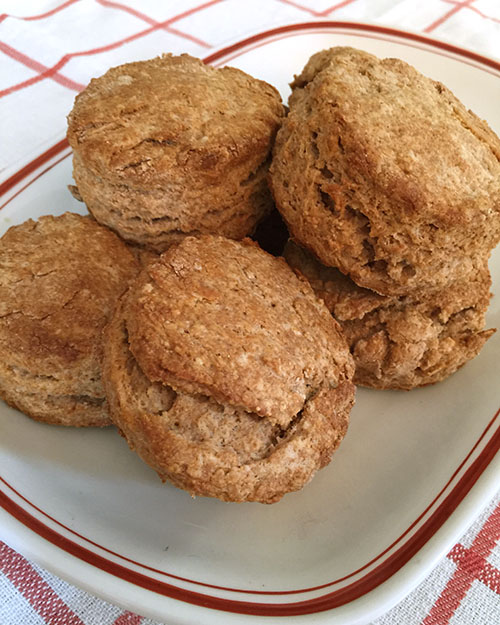
[E]ver since I discovered September was National Biscuit Month, I cannot let it go by without trying a new biscuit recipe or honoring a favorite. After all, I never knew a biscuit I didn’t like — some more than others and some haunting me still (did you know that, in the South, they leave a biscuit on your hotel pillow instead of a mint?).
When I also learned that September was National Honey Month, I thought of how ideally partnered a biscuit and honey are (honey drizzled onto a buttery biscuit!), and even better a biscuit made with honey.
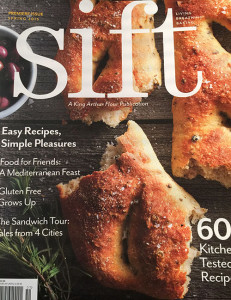 This past spring in the inaugural issue of King Arthur Flour’s Sift magazine, I ran across a recipe for some yummy-looking Honey Whole Wheat Biscuits, and put it aside specifically to celebrate this month of biscuits and honey.
This past spring in the inaugural issue of King Arthur Flour’s Sift magazine, I ran across a recipe for some yummy-looking Honey Whole Wheat Biscuits, and put it aside specifically to celebrate this month of biscuits and honey.
 For the past year, I have enjoyed the luxury of a local honey and believe that the raw honey, still infused with all the area pollens, has kept me immune from allergy reactions during the blooming seasons. My sister in Kansas has, for the last few years, kept bees and jarred her own honey. I cannot say enough about the importance of supporting apiculture and keeping the honeybee happy, healthy and thriving.
For the past year, I have enjoyed the luxury of a local honey and believe that the raw honey, still infused with all the area pollens, has kept me immune from allergy reactions during the blooming seasons. My sister in Kansas has, for the last few years, kept bees and jarred her own honey. I cannot say enough about the importance of supporting apiculture and keeping the honeybee happy, healthy and thriving.
 I LOVE the taste of any honey, including this local one that is tinged with faint licorice flavor from fennel. A little honey goes a long way, flavoring salad dressing, drizzled in tea or on toast, sweetening a healthful smoothie. I don’t go crazy consuming honey, but it finds its way in my food here and there. When I decided to make these biscuits, I was delighted to discover I still had enough left to use of the golden local.
I LOVE the taste of any honey, including this local one that is tinged with faint licorice flavor from fennel. A little honey goes a long way, flavoring salad dressing, drizzled in tea or on toast, sweetening a healthful smoothie. I don’t go crazy consuming honey, but it finds its way in my food here and there. When I decided to make these biscuits, I was delighted to discover I still had enough left to use of the golden local.
I love the flavor of whole wheat flour, too, and look for ways to use it more. I could not recall making a biscuit with it, but knew its earthy nutty flavor makes any bread good.
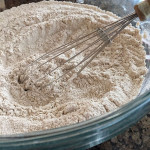 This recipe uses bread flour, too, and follows the traditional process of blending dry ingredients then cutting in fat (aka, butter). Most bakers know and understand the term “cutting in.†For those who don’t, it’s a technique of using fingers or a pastry blender (some recipes instruct to use two knives, but I’ve never tried this) to break down and blend in cold butter and/or shortening into the dry ingredients so that the butter is evenly distributed in grainy to pea-sized pieces. Everybody does it her own way, but here is a short video of yours truly doing some cutting in.
This recipe uses bread flour, too, and follows the traditional process of blending dry ingredients then cutting in fat (aka, butter). Most bakers know and understand the term “cutting in.†For those who don’t, it’s a technique of using fingers or a pastry blender (some recipes instruct to use two knives, but I’ve never tried this) to break down and blend in cold butter and/or shortening into the dry ingredients so that the butter is evenly distributed in grainy to pea-sized pieces. Everybody does it her own way, but here is a short video of yours truly doing some cutting in.
A whisked-together blend of buttermilk, egg and honey is then added to the bowl of dry ingredients and butter. The dough is a little dry and crumbly, but you knead it just a bit to bring it together.
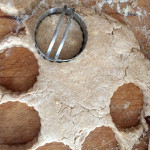 The dough is rolled or patted out (I chose to roll it) and cut into biscuit rounds. One unique step in this recipe is to brush the tops with a little extra buttermilk, which, to me, sounded like a great idea for flavor and to aid in a crisp brown crust.
The dough is rolled or patted out (I chose to roll it) and cut into biscuit rounds. One unique step in this recipe is to brush the tops with a little extra buttermilk, which, to me, sounded like a great idea for flavor and to aid in a crisp brown crust.
The finished biscuits are a beautiful golden brown, deeper in color from that whole wheat and honey. They do that magical thing that biscuits do, separating in layers as they rise and bake, making them all the more easier to split in half and top their earthy, nutty flakiness with butter and, yes, more honey.
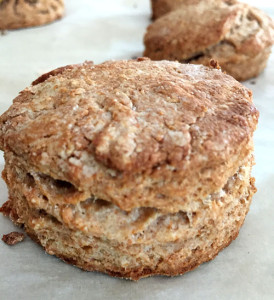
Honey Whole Wheat Biscuits
From Sift magazine (www.kingarthurflour.com)
Makes about 12 2-inch biscuits
2 1/2 cups whole wheat flour
1/2 cup bread flour
3/4 teaspoon salt
2 1/2 teaspoons baking powder
1/2 teaspoon baking soda
1/2 cup (4 ounces) cold unsalted butter
3 tablespoons honey
1 large egg
3/4 cup (6 ounces) buttermilk, plus extra for brushing tops of biscuits
Preheat the oven to 400°F. Lightly grease a baking sheet or line it with parchment paper. 

In a large bowl, whisk together the flours, salt, baking powder and baking soda. Cut in the butter until the flour mixture resembles coarse crumbs. In a small bowl or large measuring cup, whisk together the egg, buttermilk, and honey. Add, all at once, to the flour mixture, and blend lightly and quickly with a fork until the mixture is evenly moistened.

Turn the dough out onto a floured work surface, and using a bench knife or dough scraper, fold the dough over on itself three or four times, until it comes together.

Pat the dough out (or roll very lightly with a rolling pin) until it’s 3/4†thick. Cut the dough into squares or rounds with a 2†biscuit cutter, and transfer the biscuits onto the prepared baking sheet.
Brush the tops with more buttermilk, if desired.
Bake for 20 to 22 minutes, until the tops are golden brown. Remove from the oven and serve warm, or cool on a rack.